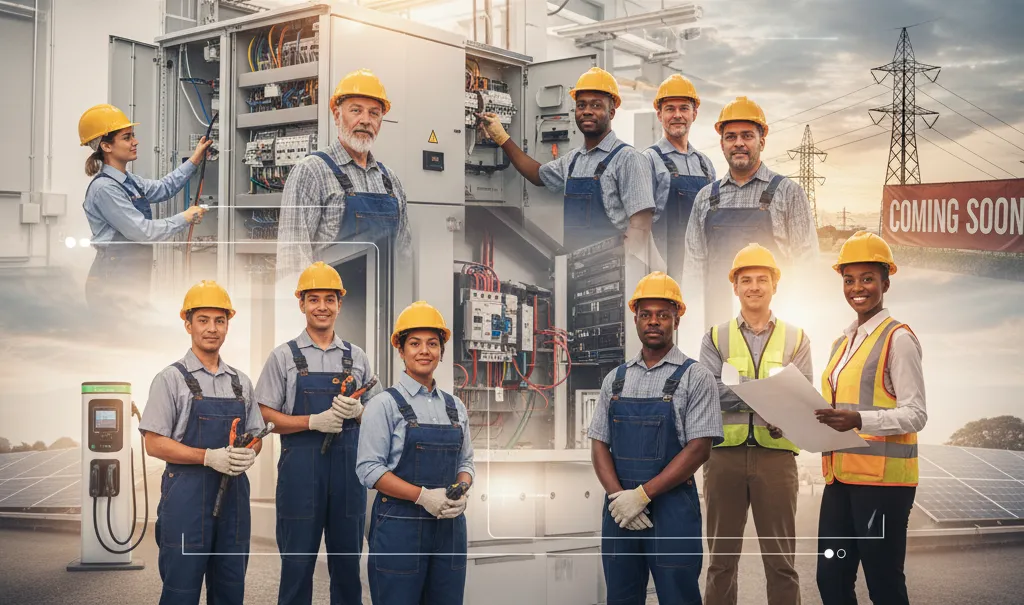Electrician Career in the U.S. 2025: Job Growth, High Salaries, and the Future of Skilled Trades
In today’s fast-changing U.S. job market, the electrician career has become one of the most resilient and high-demand professions. Once viewed as a traditional trade, it’s now at the forefront of America’s modernization — powering new homes, renewable energy systems, and the rapidly expanding electric vehicle (EV) infrastructure. From major cities to rural communities, the need for skilled electricians is surging nationwide, creating a wave of opportunity for both new entrants and experienced tradespeople.

A Career Powering America’s Growth
The U.S. economy in 2025 is heavily focused on rebuilding infrastructure, upgrading power grids, and transitioning to cleaner energy.
Electricians are essential to all of these efforts. Whether it’s wiring a high-rise apartment complex, installing solar panels, or maintaining industrial machinery, every major project requires skilled electrical expertise.
According to the U.S. Bureau of Labor Statistics (BLS), employment for electricians is projected to grow 6% between 2022 and 2032, which is faster than the national average for all occupations. That equates to around 73,000 job openings every year, primarily driven by new construction and the replacement of retiring workers.
This trend highlights one thing: the electrician career is future-proof, offering security even in uncertain economic times.
High Salaries and Real Financial Stability
In 2025, electricians enjoy one of the most competitive pay structures among all skilled trades.
The average annual salary sits around $62,000, but licensed professionals in busy metro areas can easily earn $80,000 to $100,000+ per year.
Certain specializations — such as industrial maintenance, renewable energy systems, and automation — often command even higher pay due to their technical complexity and growing demand.
Another key advantage is that electricians can earn while they learn. Most professionals start through apprenticeship programs, where they receive paid, on-the-job training while gaining classroom instruction.
This system allows workers to develop valuable skills without accumulating student debt, making it a smarter alternative to traditional college routes.
Training and Pathways to Becoming an Electrician
Unlike many careers that require years of university education, the electrician path is structured but accessible.
Here’s what it typically looks like:
- Education Foundation:
- Start with a high school diploma or GED, focusing on math, science, and basic technical skills.
- Trade School or Apprenticeship:
- Most electricians enter a formal apprenticeship program lasting 4–5 years. During this time, they complete approximately 8,000 hours of hands-on work and 600–800 hours of classroom learning.
- Licensing and Certification:
- Each state has its own licensing requirements, but most require passing a state or local electrical exam to ensure competency and safety knowledge.
- Continuing Education:
- Many electricians continue their studies through specialized certifications in renewable energy, automation, or industrial systems.
Trade schools and technical colleges across the U.S. — especially in states like Texas, Ohio, and California — are expanding their electrical programs to address the labor shortage.
Some even offer fast-track options for veterans, career changers, and high school graduates seeking immediate employment.
The Role of Electricians in the Clean Energy Transition
One of the biggest forces reshaping the profession in 2025 is the clean energy movement.
The federal government’s investments in renewable infrastructure — including solar farms, wind power, and EV charging networks — have created entirely new job categories for electricians.
Electricians today don’t just work with wires and breakers; they integrate smart technologies, sensors, and automated systems that make power use more efficient.
Popular emerging roles include:
- Solar Energy Technician – installing and maintaining photovoltaic systems.
- EV Charging Infrastructure Specialist – wiring charging stations in homes and businesses.
- Smart Home Electrician – setting up intelligent lighting and energy-efficient systems.
- Industrial Automation Electrician – managing robotic and control systems in manufacturing plants.
Each of these roles offers unique challenges, cutting-edge technology, and higher earning potential — making the electrician trade more innovative than ever.
Where the Opportunities Are: Top States Hiring Electricians
The demand for electricians is nationwide, but certain states are leading the surge in 2025.
- Texas continues to top the list with huge investments in housing and renewable energy.
- Florida is seeing growth driven by urban development and hurricane-proof infrastructure upgrades.
- California leads in green technology and EV infrastructure, offering premium wages.
- New York and Illinois remain strong markets for commercial and industrial electricians.
In rural regions, electricians are increasingly needed to maintain aging power grids and support new manufacturing facilities. Many areas are even offering relocation incentives or sign-on bonuses to attract certified workers.
A Career with Long-Term Stability and Growth
Beyond strong salaries, the electrician career offers something many jobs can’t: longevity.
Electricity remains a fundamental part of modern life — and as technology becomes more complex, so does the need for skilled workers who can install, repair, and innovate safely.
Even as automation changes other industries, electricians remain indispensable. The trade requires physical skill, problem-solving ability, and hands-on precision — all of which are difficult to automate.
Moreover, electricians often have the flexibility to choose different paths:
- Working for large contractors or unions.
- Running their own electrical business.
- Specializing in a niche like solar power or home automation.
This adaptability ensures that electricians remain in demand — and in control of their careers.
Why 2025 Is the Perfect Year to Start
If you’re considering a new direction or seeking a stable profession, 2025 is an ideal time to enter the electrician field.
The combination of national labor shortages, government incentives, and technological expansion has created unprecedented opportunities for newcomers.
Trade schools, unions, and private companies are actively recruiting apprentices, offering paid training and guaranteed job placement after certification.
And with an increasing emphasis on green energy and sustainability, electricians are playing a vital role in building America’s future.
This isn’t just about fixing wires — it’s about powering progress, supporting innovation, and building a smarter, cleaner world.
Conclusion: Powering the Future, One Connection at a Time
The electrician career in the U.S. has transformed from a traditional trade into a high-tech, high-demand profession with limitless growth potential.
It combines hands-on expertise with modern innovation, offering a rare balance of financial stability, purpose, and pride in one’s work.
As America continues to modernize, electricians stand at the center of every advancement — from the homes we live in to the vehicles we drive.
With new technologies, renewable energy systems, and nationwide development projects, the future for electricians looks brighter than ever.
So whether you’re just starting your career or looking to make a meaningful switch, remember this: electricians don’t just keep the lights on — they keep America moving forward.











